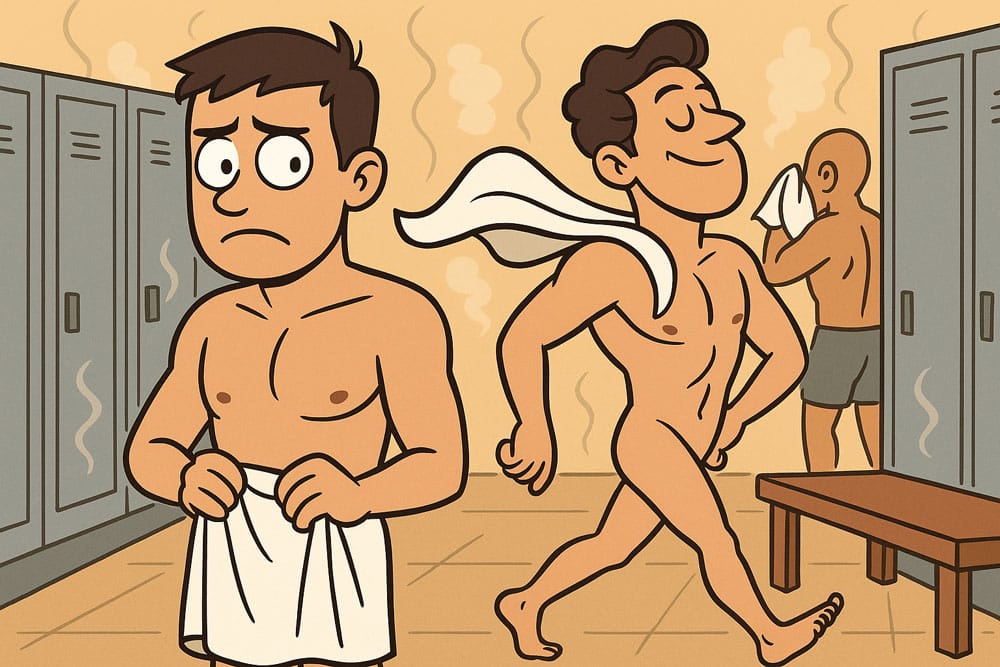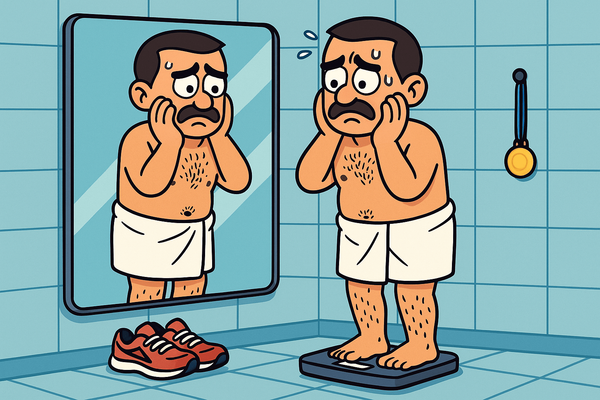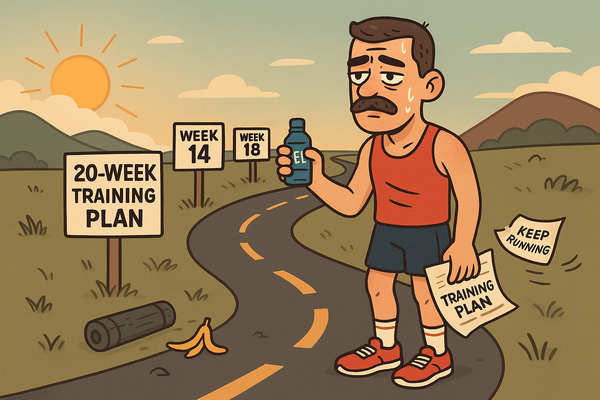Beginner gym guide: first day tips, etiquette, and common mistakes
Your first day at the gym doesn’t have to be a panic attack in Lycra. This beginner’s guide covers what to wear, changing room etiquette, and the common mistakes to avoid.

Your first day in the gym is a lot like the first day at school, except the equipment is heavier and the cool kids have creatine. If you are googling what to do on your first day at the gym, you are already ahead of the bloke curling in the squat rack. Here is everything you actually need to know, with beginner gym etiquette baked in so you do not get side-eyed for doing squats in the bicep curl rack.
None of this is gospel, by the way. It’s just ideas and suggestions. The main thing is showing up. You will make mistakes and that’s okay, it’s your journey and you will learn along the way.
What to bring and what to wear
You do not need a suitcase of your finest outfits, but you do need enough to be comfortable while avoiding odour and social exile.
- Shoes: any clean trainers with a firm sole are fine. Flatter is better if you want to include leg exercises like squats and deadlifts - squishy running shoes make heavy lifts feel wobbly, and the heel-to-toe drop will impact your form. Think Converse or stable cross-trainers. Though keep in mind this is the ‘ideal’ option: if all you have are running trainers, wear them. The main thing is to make it to the gym.
- Clothes: anything you feel comfortable moving and sweating in. This is highly personal, for some people that’s a cotton t-shirt and heavy tracksuit bottoms. For me it’s a high wicking vest or t-shirt and a pair of skimpy shorts. As long as your clothes don’t stink, you’re good to go. If your T-shirt is 10 years old and comes with an instant cheese fragrance the second you break a sweat, you may want to invest in a new one.
- Hygiene kit: A small towel, deodorant and a water bottle will all come in handy. The small towel means you can dry yourself off when you get sweaty, and/or wipe down your sweat from the equipment after you’re done. Deodorant, because it’s good to be prepared for a stink emergency, and a water bottle because staying hydrated is really quite beneficial. Depending on your gym, some or all of these items may be provided.
- Lock or coin: This also depends on your gym, some are still old school and have padlocks, some are even more old school and insist on a coin to operate the locker like it’s still 1997. Personally I haven’t been to a gym that needed either for many years - pin codes for locking/unlocking are fairly common.
Gym changing room etiquette
The changing room is a zoo without cages. Some people stalk around like silverback gorillas, others cower in the corner like meerkats. The trick is blending in without becoming the weird exhibit yourself.
- Nudity: if you’re in Germany or Scandinavia you have nothing to be worried about: full frontal nudity is strongly encouraged. If anything, it is weird for you to be modest in the changing rooms. If you’re in the UK or the US - changing rooms is not a place to prance around with your bits out on full display. Unless of course you're feeling the homoeroticism and decide to turn the changing room into your personal cruising ground. Then by all means, go and enjoy yourself. But keep it discreet and consensual or you might risk being banned. I hear this is wildly different for ladies, I don’t have any first-hand experience of the ladies changing rooms so feel free to share in the comment section.
- Phones: absolutely no photos in here. Even “just checking a message” while holding a camera in a room full of undressed people is unacceptable.
- Sweaty gym kit: your sweat soaked underwear and stinky socks do not belong on a bench. Shove them in a bag, lock them away and pretend they don’t exist. Leaving your filthy pants on the bench while you have a shower probably means some poor sod will have to move them. If there is only you and one other person in the locker room, the other person is most likely using the locker next to yours. And they probably don’t want to touch your stinky pants.
- Showers: Just don’t do anything weird. And if you do do something weird, intentionally or by accident, clean up after yourself and leave no trace of your filthy behaviour.
Gym floor etiquette for beginners: do not be that person
Re-rack your weights every time. If you could lift it up to use it, you can put it back where you found it. Plates return to their trees, dumbbells go in numerical order, barbells do not live on the floor.
Wipe equipment. Your sweat is completely normal and also completely not my problem. Paper towel, a squirt of spray, quick wipe on pads and handles, done.
Do not camp on your phone. I’m all for long rest periods, but there are far too many people who get sucked into their phones and forget when their rest is over. Your rest is not the time to watch the next episode of EastEnders. If you’re taking a longer rest, why not rest from your screen too? Have a look around. Drink some water. Stretch your calf. I sometimes take 4-5 minute rests, but be prepared to share the kit and make sure you keep an eye on the time so you don’t end up with a 45 minute rest.
Mirrors are for form. Use them. Check your posture, angles, perfecting your technique. Do not use them for selfies, filming or doing your makeup.
First time lifting weights at the gym: how to use machines without looking lost.
The way I see it, there are four learning options, ranked by dignity saved per minute:
- Test and learn. Walk up to each machine, take a seat, or a stand, a lean, perhaps a lie down? Who knows. Just find a position that seems reasonable, then figure out if you need to push something or pull something, most likely with your arms or your legs. Will people look at you and judge you? Maybe. But they might also be wondering what that machine is doing and they are secretly hoping you’ll show them. If you’re the kind of person who walks around like you own the place, this option is probably quite easy. Personally, just writing this is making my hands sweat.
- Take photos and Google later. Photograph the machine’s nameplate and the adjustment points. At home, search “Technogym lat pulldown setup” or similar. Watch a video or two, then revisit the gym and you’ll have a much better idea of what limbs go where.
- Free induction tour. Take it. Ask to learn four machines only: leg press, lat pulldown, chest press, cable row. Get the seat numbers or notch positions and write them in your notes, or you will forget. Best case scenario, you will have a vague idea how to use 4 machines. They do cover the 4 main lifts, so it’s a really solid start, and you can then continue with one of the other options to learn how to use more machines.
- Pay for PT sessions. A couple of sessions will get you going with a basic routine, but if your budget allows, I would highly recommend getting a PT, and get them to teach you the compound lifts. Depending on your body and your current fitness levels, you may need to work on mobility and strength drills before even hitting the big compound lifts, but once you master those, you’ve unlocked the cheat codes of the gym. Squat, deadlift, bench, overhead press: four lifts that make up 80% of what people post online while pretending they invented fitness.
How often to go to the gym as a beginner
As a beginner, you should hit the gym with whatever frequency you can commit to and be consistent with. If that’s once a week - great! You will see gains from once a week, but if you can up it to two, maybe even three sessions per week, you’ll see even greater gains. Anything above three times per week, ask yourself if that’s really sustainable. It’s easy to go in too hard and then lose momentum and stop completely after a few weeks because results did not happen quickly enough. The reality is: as a beginner, anything over three times per week will only give you marginal gains, and your risk for injury increases exponentially with the increased frequency.
Should I still work out with DOMS?
Yes, but with some exceptions. If you have severe DOMS and struggle to do basic things like sitting down on the toilet, a rest day might be a good idea, but if you can, this is a great time to put some time into stretching and mobility, perhaps a gentle yoga class. And if it’s so severe you’re MIA for 4-5 days, you might want to go lower on the intensity to allow yourself to up the frequency. Just because you can squat 100kg doesn’t mean you should. It’s okay to drop it down a touch and go to almost failure rather than actual failure.
Gym mistakes to avoid for beginners
- Ego lifting: Going heavy can make you feel like the hulk, but only momentarily. Your joints will quickly remind me that you are still a mere human, and a weak one at that.
- Copying influencers: They’ve done this for years. Some of it might even look easy, but as a complete beginner, your plan should be achievable and repeatable without causing injury. By all means look at influencers to find inspiration in what the human body can achieve and set goals for yourself. Perhaps you want to learn to do a pull up, or even just a press up - these are great goals to have. But set realistic expectations and long-term goals. Learning to do a pull up can take anything from 3-12 months depending on your starting fitness level and how dedicated you are. Personally it took me ~6 months with pull up drills at least twice weekly.
- Trying every machine in one day: You don’t need to do a full circuit of the machines to get results, what you want is consistency and repetition over a long period of time. Instead, pick four movements and learn them well.
- Skipping warm ups: Warm ups can get really elaborate with bands and mobility drills, which is great if you know what you’re doing and have the patience of a yoga teacher. As a beginner, you don’t need all that (yet). The point of a warm up is twofold: get your muscles and joints physically warm, and remind your body what movement it’s about to do. If you’ve just walked in straight from the cold, hop on a bike or treadmill for 5 minutes to raise your body temperature. If it’s scorching and you just legged it from the office and you’re already dripping in sweat, I wouldn’t worry about the cardio. Either way, before any exercise, do one or two super-light sets of the lift you’re about to perform, think half the weight or less. For example for squats, start with bodyweight or an empty bar. It doesn’t have to be complicated — it just has to make your body feel like “oh right, this is today’s suffering”.
- Ignoring recovery: sleep and protein matter. Possibly even more than your workout routine. Mastering your sleeping habits and protein intake (aim for 1.6-2.2g per kg of your ideal body weight) will do more for your progress than any fancy rep scheme. You can butcher a workout and still make gains if you sleep well and hit your protein. Do the reverse — train hard, sleep 4 hours, eat like a toddler — and you’ll wonder why you’re not growing.
The truth about beginner gym anxiety
The hardest part of starting out in the gym is actually getting yourself to the gym. You might think everyone will be watching and judging you, but in reality, most people are only watching themselves, worrying that others are watching and judging them. If anxiety spikes, give yourself a script. Arrive, warm up, do four movements, log it, leave. And if you’re having a bad day, leave part way through the warm up. Exposure works, and by showing up repeatedly it will eventually become second nature.
If you survived your first session, congratulations! You’re now a gym-goer. Not a perfect one, not an influencer with a tripod, but a person who turned up and tried. Come back in two days, do it again, add one rep or a tiny plate, and six weeks from now you’ll feel like a local. The secret isn’t never making mistakes — it’s showing up enough times that they stop mattering.





